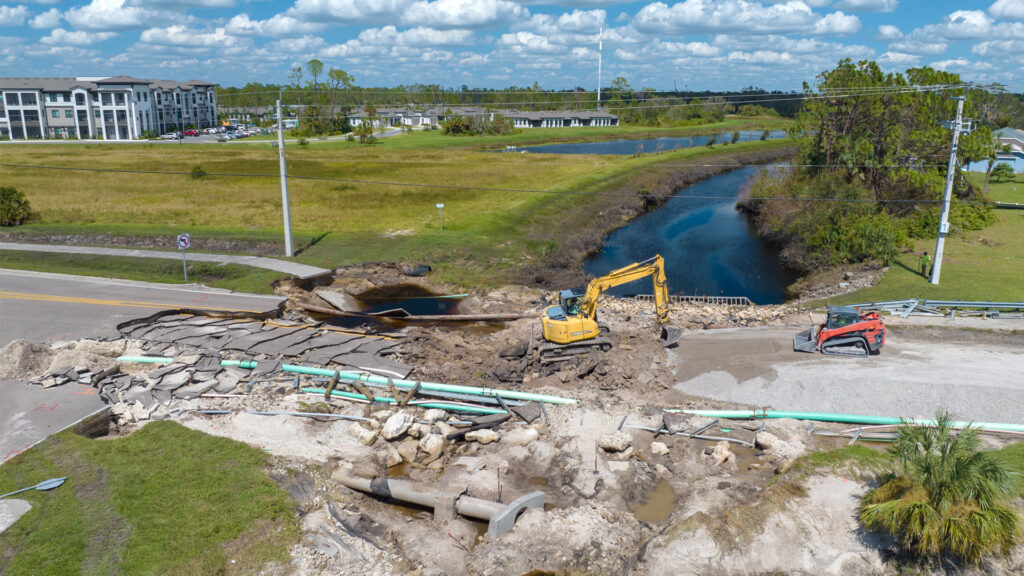By Sean D. Lahav, Halff
Florida, with its expansive coastlines and low-lying terrain, is no stranger to flooding. Throughout history, Floridians have endured widespread impacts caused by hurricanes, storm surges and rainfall events. Impacts from hurricanes Irma (2017), Michael (2018), Ian (2022), Idalia (2023) and Debby (2024) are etched into recent memory.
As flood events become more economically destructive — where Hurricane Ian caused the second-largest insured loss on record after Hurricane Katrina with approximately $65 billion in insured damages — the Sunshine State faces increasing challenges of safeguarding its communities, infrastructure and economy.
Amid these historical and persistent threats, the state has harnessed the power of collaboration and “resilience thinking” to tackle flood vulnerabilities through holistic approaches to planning and action.

Resilience is defined as the ability of community systems to bounce back from adverse impacts and adapt to evolving conditions. It is now increasingly pivotal in infrastructure planning and economic development. While “collaboration” and “resilience” are often seen as buzzwords, these terms have been used as guiding principles for community investment decisions across Florida.
The Resilient Florida program, established in 2021, has funded more than $1 billion in grants to support municipalities and counties with identifying flood vulnerabilities and constructing infrastructure projects that will mitigate these vulnerabilities.
Regional planning councils, water management districts and state universities, which operate across jurisdictional boundaries, have developed projects aimed at solving complex intergovernmental challenges.
At the local level, municipalities and counties have appointed chief resilience officers to coordinate planning and implementation across governmental departments. In the backdrop of these efforts, private sector innovations — including real-time flood forecasting systems and predictive mapping techniques — are driving solutions forward.
This ensures that current infrastructure investments can withstand future impacts.
State and local government agencies are working together with community organizations, stakeholders, businesses and academic institutions to develop comprehensive flood resilience strategies. These collaborations have brought about significant changes across the state.

These changes include transformative infrastructure upgrades, innovative nature-based solutions, enhanced public awareness and a bipartisan sense of urgency in solving statewide challenges. While collaboration has resulted in substantial progress, barriers still exist. Competing priorities, limited fiscal resources and jurisdictional complexities can hinder effectiveness and slow progress.
As the nation’s third most populous state, home to several metro areas among the top U.S. population gains in recent years, the most complex challenge faced relates to building resilience while maintaining economic growth and prosperity. Building a more resilient Florida will take all of us to tackle these challenges.
Florida’s ongoing and evolving leadership in collaborative resilience planning offers valuable lessons for other regions or states in addressing complex environmental challenges. By working together, we can leverage shared expertise and resources to inspire collective action.
Sean D. Lahav, MPA, is the resilience market leader at Halff, an infrastructure consulting firm. He lives in Jacksonville. This opinion piece was originally published by the Florida Times-Union, which is a media partner of The Invading Sea.
If you are interested in submitting an opinion piece to The Invading Sea, email Editor Nathan Crabbe at ncrabbe@fau.edu. Sign up for The Invading Sea newsletter by visiting here. To learn more about resilience, watch the video below.




Please look into regenerative agricultural at rootssodeep.org. Soils high in organic matter absorb much more water, and amp grazing enhances deep root development of native species, minimizing errosion.
Decisions not to rebuild in coastal areas must be made. Mitigation is another choice. Rebuilding as it was is not viable.